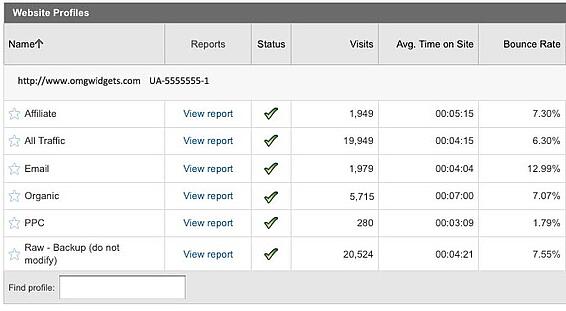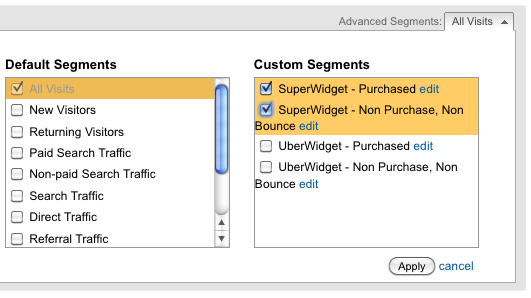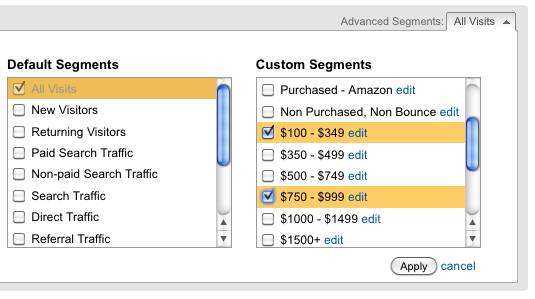Many (and by now I HOPE most) sites have some form of web analytics implemented; be it Clicktale, Webtrends, Yahoo, or the ever popular Google Analytics. Many business owners or internal marketers speak of their web analytics like a grandmother speaks of her new computer: "It's looks complicated. What do I do with it?" For something that's free and relatively easy to install, it's no wonder so many have it. The reality is most don't harness its true power, but only scratch the surface - the equivalent of using your brand new Macbook Pro to only check Facebook.
Like social media sites, just having the analytics (or Facebook page, or Twitter account) won't get you anything. It won't get you traffic, it won't build your brand, it won't explain why your shopping cart has a 99.8% abandonment rate. Yes, the data and potential is there, but without the proper groundwork and planning, you'll have a very difficult time adding any value to the business.
To have any impact, you first have to identify what you're trying to impact.
It sounds obvious, but it isn't always. Most managers/bosses/owners will tell you "Well, I want sales to improve, of course!" While it's an understandable response, it's the equivalent of telling a doctor, "Doc, make my life better."
On the bright side, learning that their sales need improving gives us a starting point. We can view shopping cart funnel data, bounce rates and conversion by traffic source and keywords, etc.. Basic run of the mill web analytics analysis, more or less. Continuing with the medical analogy, after being asked to improve your life, the doctor would give you a physical, interview your friends and family members, then come back with a list of recommendations on how you can make your life better.
This isn't too hard to pull off, but the problem is the method is not unique to you. A turn key approach is never unique enough to solve and improve your unique problems.
So how do you get past the generic "make my sales better," response? You ask to dive deeper. If the owner doesn't have the time to get into the nitty gritty (which is understandable - they're trying to run a business, after all) ask who's the next best person to speak with. It could be internal marketers, analysts, consultants, etc.
Now that you're speaking to more micro-focused individual or team, we need to start identifying more manageable goals to achieve the ultimate goal of "better sales."
Sales happen because of customers. If we want sales to improve, we need to better understand our customers. "Customers" as one large bucket is still way too large to analyze and draw actionable insight from (at least, in the age of web analytics it is). Find out which kind of customers they want to know more about. A large ecommerce site may want to know how effective its email marketing and affiliate program channels are doing when it comes to sales. BOOM! A couple new Account profiles here, some custom filters there, and now we have two reports for just email marketing visitors and affiliate program visitors.

Sticking with the ecommerce scenario, identify next what product categories are most profitable for the business. If UberWidgets are the most profitable followed by SuperWidgets, use custom segments to break your reports into those who purchase UberWidgets and SuperWidgets as well as those who look at UberWidgets and SuperWidgets but don't purchase.

Combining these segmentations with the reports showing only email or affiliate traffic, we can see how each referral source performs when it comes to producing the highest ticket sale. Comparing the purchased traffic versus the non-purchased traffic for a single product category, we can easily uncover what's different about those who buy versus those who don't. If your product lines and prices range significantly, you can break down price levels using custom segments (more achievable with properly configured ecommerce reporting).

We're starting to get some great data, but don't stop here!
Say your business offers incentives or extended options for those in close geographic proximity to the physical store. For example, you're headquartered and have stores in Richmond, Virginia but ship nationwide. Central Virginia residents can have their purchase picked up in store to save on shipping costs. With this added incentive, it would be worth your time to individually segment Virginia web traffic and see how their behavior differs from those who can only have their purchase shipped.
These exercises can be done over and over with different variations - each time uncovering more of your data's story. We are no longer asking the doctor to make our life better, but instead asking him to fix the pain we experience in our right shin when we go running. The more specific we are in what we're trying to improve, the better chance we have of making an impact.





Agree, disagree, or just have something to add?
Leave a comment below.